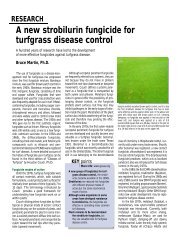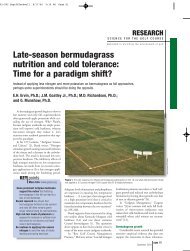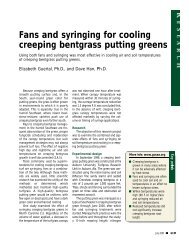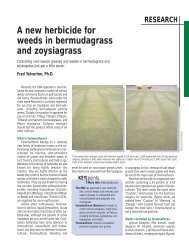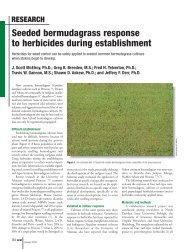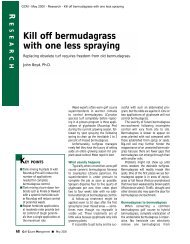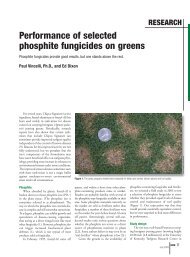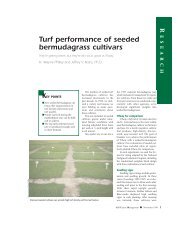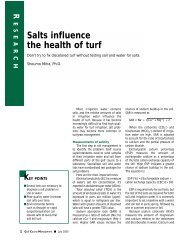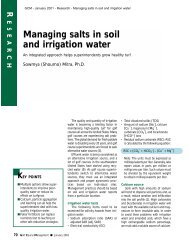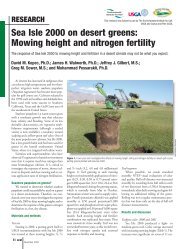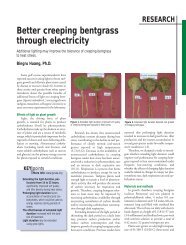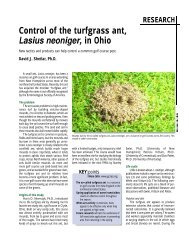Controlling moss in putting greens - GCSAA
Controlling moss in putting greens - GCSAA
Controlling moss in putting greens - GCSAA
You also want an ePaper? Increase the reach of your titles
YUMPU automatically turns print PDFs into web optimized ePapers that Google loves.
RESEARCHputt<strong>in</strong>g <strong>greens</strong> probably reflects recenttrends <strong>in</strong> putt<strong>in</strong>g green culture, <strong>in</strong>clud<strong>in</strong>gextremely low mow<strong>in</strong>g, m<strong>in</strong>imal nitrogenf e r t i l i z e r, <strong>in</strong>creased use of sand grow<strong>in</strong>gmediums, <strong>in</strong>tense sand topdress<strong>in</strong>g andloss of mercury fungicides, which werehighly toxic to <strong>moss</strong>. It occurs on bothbentgrass and Poa annua <strong>greens</strong> but isby far a bigger problem on sand-basedbentgrass <strong>greens</strong>. We have found significantpopulations on first-year <strong>greens</strong>on new golf courses. It often shows upfirst <strong>in</strong> weak areas such as ridges andmounds where grass is th<strong>in</strong> because ofscalp<strong>in</strong>g or drought stress. It aggressivelycolonizes low, wet areas andthrives on soil-based <strong>greens</strong> with shallowlayers of sand built up by topdress<strong>in</strong>g.Research strategiesOur research, conducted at OregonState University, primarily concerns <strong>moss</strong>grow<strong>in</strong>g <strong>in</strong> creep<strong>in</strong>g bentgrass <strong>greens</strong>,and the follow<strong>in</strong>g results are from workdone entirely on Providence creep<strong>in</strong>gbentgrass <strong>in</strong> sand-based grow<strong>in</strong>g mediumsand SR 7200 velvet bentgrass grow<strong>in</strong>gon soil and topdressed with sand. Todate we have concentrated on large-scalebroadcast treatments rather than spottreatments directed at localized <strong>in</strong>festations.Most of the chemical treatmentshave been applied dur<strong>in</strong>g fall and w<strong>in</strong>terwhen temperatures range from 40 to 65 Fand moisture from precipitation is common.Soil pH <strong>in</strong> the area is typically 5.5 to6.5, and salt levels are very low.Early screen<strong>in</strong>g trialsAfter unsuccessful attempts by super<strong>in</strong>tendentsto try iron products at normalputt<strong>in</strong>g green rates, we screened a widerange of products by apply<strong>in</strong>g each at avariety of rates from low to very high.Products <strong>in</strong>cluded <strong>in</strong> our experimentswere selected because reports <strong>in</strong> the literature<strong>in</strong>dicated that they controlled <strong>moss</strong> orthat they were be<strong>in</strong>g applied on putt<strong>in</strong>g<strong>greens</strong> <strong>in</strong> an attempt to control <strong>moss</strong>. Weelim<strong>in</strong>ated products that caused turf damageand others that had no effect on the<strong>moss</strong>. The follow<strong>in</strong>g products were testedand elim<strong>in</strong>ated from consideration.Copper sulfate. Copper sulfate is notlabeled for <strong>moss</strong> control. In our tests, itRelative residual <strong>moss</strong> control <strong>in</strong> plots treated the previous w<strong>in</strong>ter with junction ( Copper Hydroxide + Mancozeb),No-Mas(fatty acid soas),daconil fungicide,and an untreated check plot.caused severe turf <strong>in</strong>jury at rates necessaryfor <strong>moss</strong> kill. Caused root stunt<strong>in</strong>g <strong>in</strong>t u r f .Copper soaps. Copper soaps are notlabeled for <strong>moss</strong> control. We found themto be highly effective <strong>moss</strong> killers but toxicto turf, even at moderate rates.Z<strong>in</strong>c sulfate. These products are notlabeled for <strong>moss</strong> control <strong>in</strong> putt<strong>in</strong>g <strong>greens</strong>,although some retail products are labeledfor <strong>moss</strong> control <strong>in</strong> lawns. A c c e p t a b l e<strong>moss</strong> control but caused significant turf<strong>in</strong>jury at marg<strong>in</strong>ally high rates.Daconil Zn and Daconil Ultrex. Bothproducts are labeled as fungicides andnot for <strong>moss</strong> control. They were <strong>in</strong>eff e c-tive <strong>in</strong> controll<strong>in</strong>g <strong>moss</strong> under low-temperatureconditions. Some reports<strong>in</strong>dicate control at higher summer temperatures.No undesirable side effects onturf even after 15 repeat treatments.Dawn Ultra. Dawn Ultra was <strong>in</strong>eff e c-tive on <strong>moss</strong> at rates rang<strong>in</strong>g from 2 to 8ounces of product/1,000 square feetwhen applied dur<strong>in</strong>g cool, wet conditions.Dawn Ultra is marketed as a dishwash<strong>in</strong>gliquid, and certified commercial pesticideapplicatorscannotlegally apply Dawn Ultra for <strong>moss</strong> control.Do<strong>in</strong>g so would be the same as apply<strong>in</strong>gan unregistered pesticide.Advanced screen<strong>in</strong>gThe next phase <strong>in</strong>volved further test<strong>in</strong>gof products that showed promise for<strong>moss</strong> control and caused little or no turfi n j u r y. Products <strong>in</strong>cluded ferrous and ferricsulfate, fatty acid soaps and copperhydroxide products. All of these havebeen tested repeatedly at several ratesand with vary<strong>in</strong>g numbers of repeat applications.Research results for these productsare summarized below.Iron productsNormal rates of iron for turf colorenhancement are about 0.03 poundiron/1,000 square feet. Under cool, wetconditions, rates of 0.15 to 0.20 poundiron/1,000 square feet controlled <strong>moss</strong>marg<strong>in</strong>ally without <strong>in</strong>jury or blacken<strong>in</strong>g ofProvidence creep<strong>in</strong>g bentgrass turf.Ferric sulfate is more effective at kill<strong>in</strong>g<strong>moss</strong> than ferrous sulfate, but bothrequire a series of five to seven treatmentsapplied at two-week <strong>in</strong>tervals. Tu r fis exceptionally dark green dur<strong>in</strong>g treatment.We achieved up to 90 percent<strong>moss</strong> control with both ferrous and ferricsulfate, which is encourag<strong>in</strong>g but not aseffective as we would like. Annual applicationsmay be necessary, and control isnot always consistent. Field test resultshave been mixed, with most tests us<strong>in</strong>gferrous sulfate and report<strong>in</strong>g fair to goodGCM



